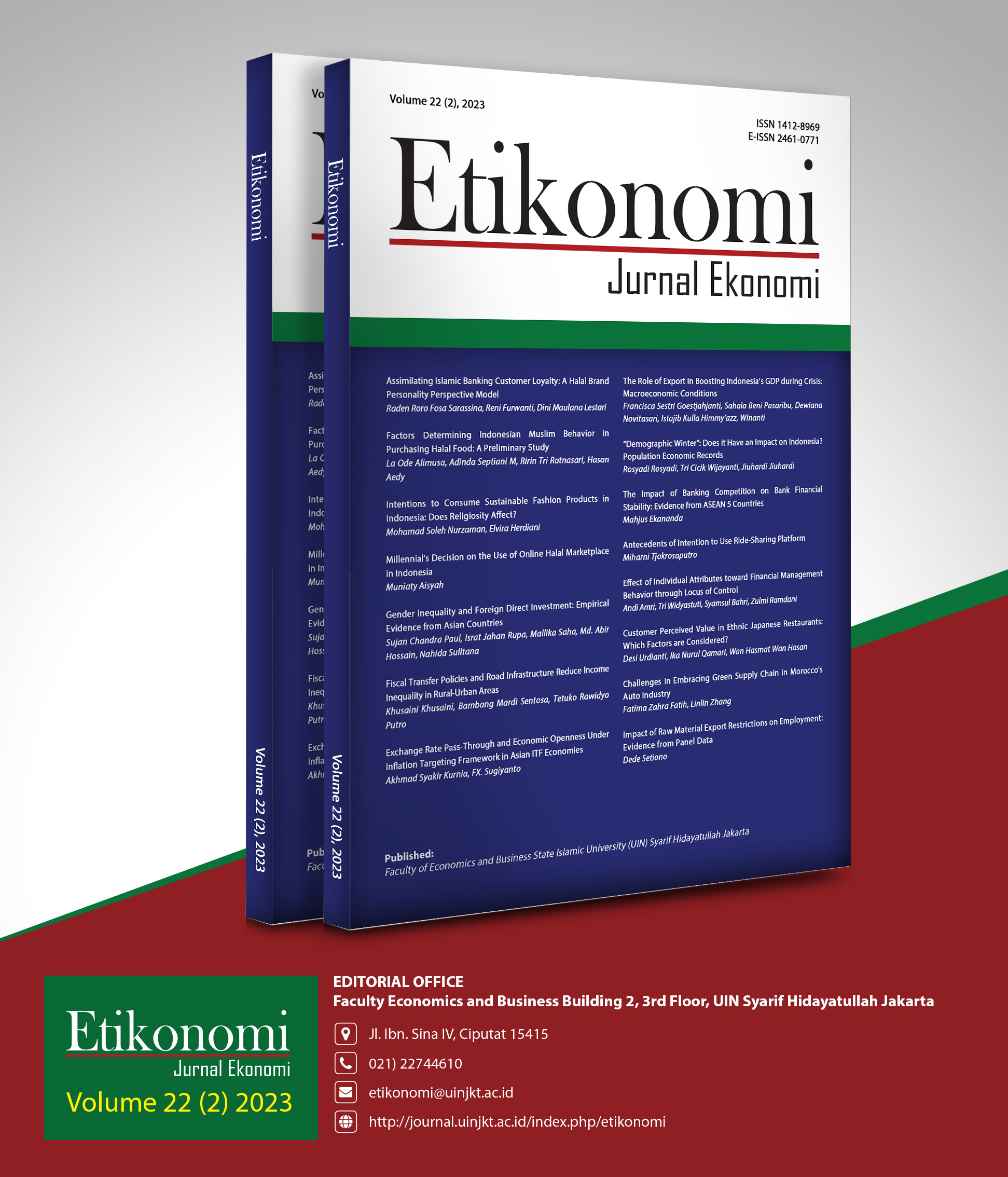Impact of Raw Material Export Restrictions on Employment: Evidence from Panel Data
DOI:
https://doi.org/10.15408/etk.v22i2.32172Keywords:
raw materials, export restriction, employment, extractive industriesAbstract
The extractive industry typically contributes limited direct employment in host countries, prompting some nations to consider export restrictions on raw materials to enhance domestic job opportunities. However, scholarly opinions on the efficacy of these policies vary widely. This study addresses this gap by utilizing an extensive dataset spanning over a decade and encompassing diverse countries. Employing a fixed-effect Ordinary Least Square (OLS) regression model with panel data from 74 countries from 2009 to 2021, this paper shows that raw material export restrictions do not affect employment rates. This fact challenges the prevailing notion that export restrictions inherently boost domestic employment. Consequently, a more comprehensive strategy, including economic diversification, technological investment, and alternative job creation measures alongside export controls, is essential to effectively address employment challenges within the extractive sector. JEL Classification: F1, J2, O1How to Cite:
Setiono, D. (2023). Impact of Raw Material Export Restrictions on Employment: Evidence from Panel Data. Etikonomi, 22(2), 483 – 494. https://doi.org/10.15408/etk.v22i1.32172.
Downloads
References
Addison, Tony, & Alan Roe. (2018). Extractive Industries: The Management of Resources as a Driver of Sustainable Development. Northamptonshire: Oxford University Press.
Aragón, F. M., & Rud, J. P. (2013). Natural Resources and Local Communities: Evidence from a Peruvian Gold Mine. American Economic Journal: Economic Policy, 5(2), 1-25.
Aw, B. Y., Roberts, M. J., & Xu, D. Y. (2011). R&D Investment, Exporting, and Productivity Dynamics. American Economic Review, 101(4), 1312-1344.
Balistreri, E. J., & Worley, C. M. (2009). Mercury: The Good, The Bad, and The Export Ban. Resources Policy, 34(4), 195-204.
Bas, M. (2012). Technology Adoption, Export Status, and Skill Upgrading: Theory and Evidence. Review of International Economics, 20(2), 315-331.
Bernard, A. B., & Jensen, J. B. (2004). Why Some Firms Export. Review of Economics and Statistics, 86(2), 561-569.
Bown, C. P., Erbahar, A., & Zanardi, M. (2021). Global Value Chains and the Removal of Trade Protection. European Economic Review, 140, 103937.
Brambilla, I., Chauvin, N. D., & Porto, G. (2014). Wage and Employment Gains from Exports: Evidence from Developing Countries. Working paper, African Center for Economic Transformation (ACET).
Daudin, G., Rifflart, C., & Schweisguth, D. (2011). Who Produces for Whom in the World Economy?. Canadian Journal of Economics, 44(4), 1403-1437.
Dergachova, V., Dunska, A., Holiuk, V., Lutsenko, I., & Pichugina, M. (2021). Export Concentration and Diversification Impact on Economic Growth in the Developed and Developing Countries of the World. Economic Annals-XXI, 192(7-8(2)), 26-37.
Fajgelbaum, P. D., Goldberg, P. K., Kennedy, P. J., & Khandelwal, A. K. (2020). The Return to Protectionism. The Quarterly Journal of Economics, 135(1), 1-55.
Fliess, B., Idsardi, E., & Rossouw, R. (2017). Export Controls and Competitiveness in African Mining and Minerals Processing Industries. OECD Trade Policy Papers, No. 204. OECD Publishing.
Fu, X., & Balasubramanyam, V. N. (2005). Exports, Foreign Direct Investment and Employment: The Case of China. The World Economy, 28(4), 607-625.
Fujio, K. A. (2013). China—Measures Related to the Exportation of Various Raw Materials (DS394, DS395, DS398): A State of Play and Challenges of Interpretation Related to Disciplines on Export Restraints (Japanese) (No. 13015). WTO Case Review Series, No. 7. Research Institute of Economy, Trade and Industry (RIETI).
Fung, K. C., & Korinek, J. (2013). Economics of Export Restrictions as Applied to Industrial Raw Materials. OECD Working Paper, No. 155. OECD Publishing.
Handley, K., Kamal, F., & Monarch, R. (2020). Rising Import Tariffs, Falling Export Growth: When Modern Supply Chains Meet Old-style Protectionism. International Finance Discussion Paper, No. 1270.
Jacob, T., & Pedersen, R. H. (2018). New Resource Nationalism? Continuity and change in Tanzania’s Extractive Industries. The Extractive Industries and Society, 5(2), 287-292.
Kasahara, H., Liang, Y., & Rodrigue, J. (2016). Does Importing Intermediates Increase the Demand for Skilled Workers? Plant-level Evidence from Indonesia. Journal of International Economics, 102, 242-261.
Kim, J. (2010). Recent Trends in Export Restrictions. OECD Trade Policy Papers, No. 101. OECD Publishing.
Kinnaman, T. C. (2011). The Economic Impact of Shale Gas Extraction: A Review of Existing Studies. Ecological Economics, 70(7), 1243-1249.
Korinek, Jane & Kim, J. (2010). Export Restrictions on Strategic Raw Materials and Their Impact on Trade. OECD Trade Policy Papers No. 95. OECD Publishing
Korinek, J., & Kim, J. (2011). Export Restrictions on Strategic Raw Materials and Their Impact on Trade and Global Supply. Journal of World Trade, 45(2), 255-281.
Latina, J., Piermartini, R., & Ruta, M. (2011). Natural Resources and Non-Cooperative Trade Policy. International Economics and Economic Policy, 8, 177-196.
Mancheri, N. A., Sprecher, B., Bailey, G., Ge, J., & Tukker, A. (2019). Effect of Chinese Policies on Rare Earth Supply Chain Resilience. Resources, Conservation and Recycling, 142, 101-112.
Massari, S., & Ruberti, M. (2013). Rare Earth Elements as Critical Raw Materials: Focus on International Markets and Future Strategies. Resources Policy, 38(1), 36-43.
Matsushita, M. (2011). Export Control of Natural Resources: WTO Panel Ruling on the Chinese Export Restrictions of Natural Resources. Trade Law & Development, 3, 267-275.
Milner, C., & Tandrayen, V. (2007). The Impact of Exporting and Export Destination on Manufacturing Wages: Evidence for Sub‐Saharan Africa. Review of Development Economics, 11(1), 13-30.
OECD. (2019). Aid for Trade at a Glance 2019: Economic Diversification and Empowerment. Paris: OECD Publishing.
Östensson, O. (2019). Promoting Downstream Processing: Resource Nationalism or Industrial Policy?. Mineral Economics, 32, 205-212.
Östensson, O. (2020). The Potential of Extractive Industries as Anchor Investments for Broader Regional Development. WIDER Working Paper No. 2020/87.
Roe, A. R. (2017). Tanzania-from Mining to Oil and Gas: Structural Change or Just Big Numbers?. WIDER Working Paper No. 2017/175.
Turco, A. L., & Maggioni, D. (2013). Does Trade Foster Employment Growth in Emerging Markets? Evidence from Turkey. World Development, 52, 1-18.
Vyboldina, E., Cherepovitsyn, A., Fedoseev, S., & Tsvetkov, P. (2016). Analysis of Export Restrictions and Their Impact on Metals World Markets. Indian Journal of Science and Technology, 9(5), 87633.
Wübbeke, J. (2013). Rare Earth Elements in China: Policies and Narratives of Reinventing an Industry. Resources Policy, 38(3), 384-394.










